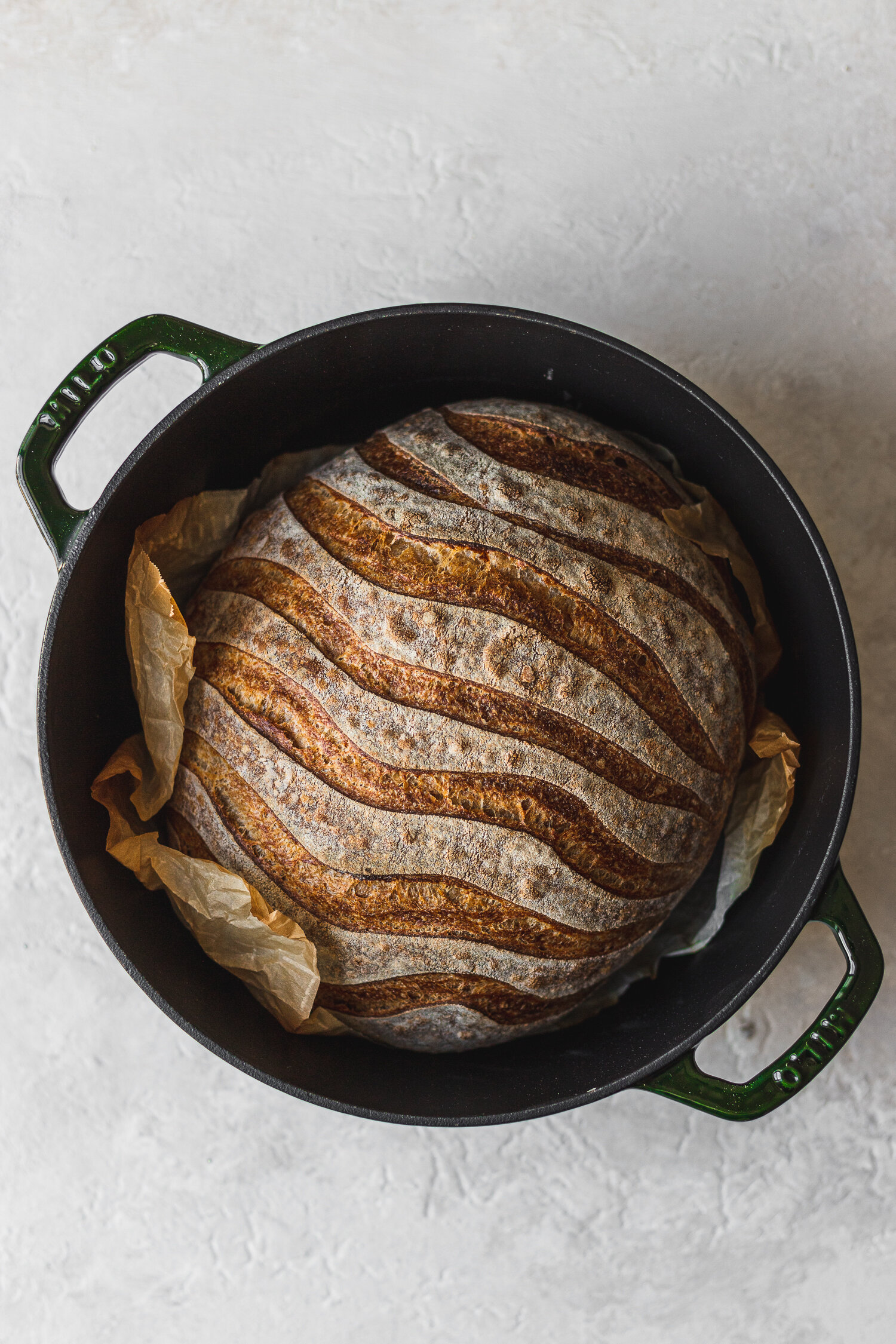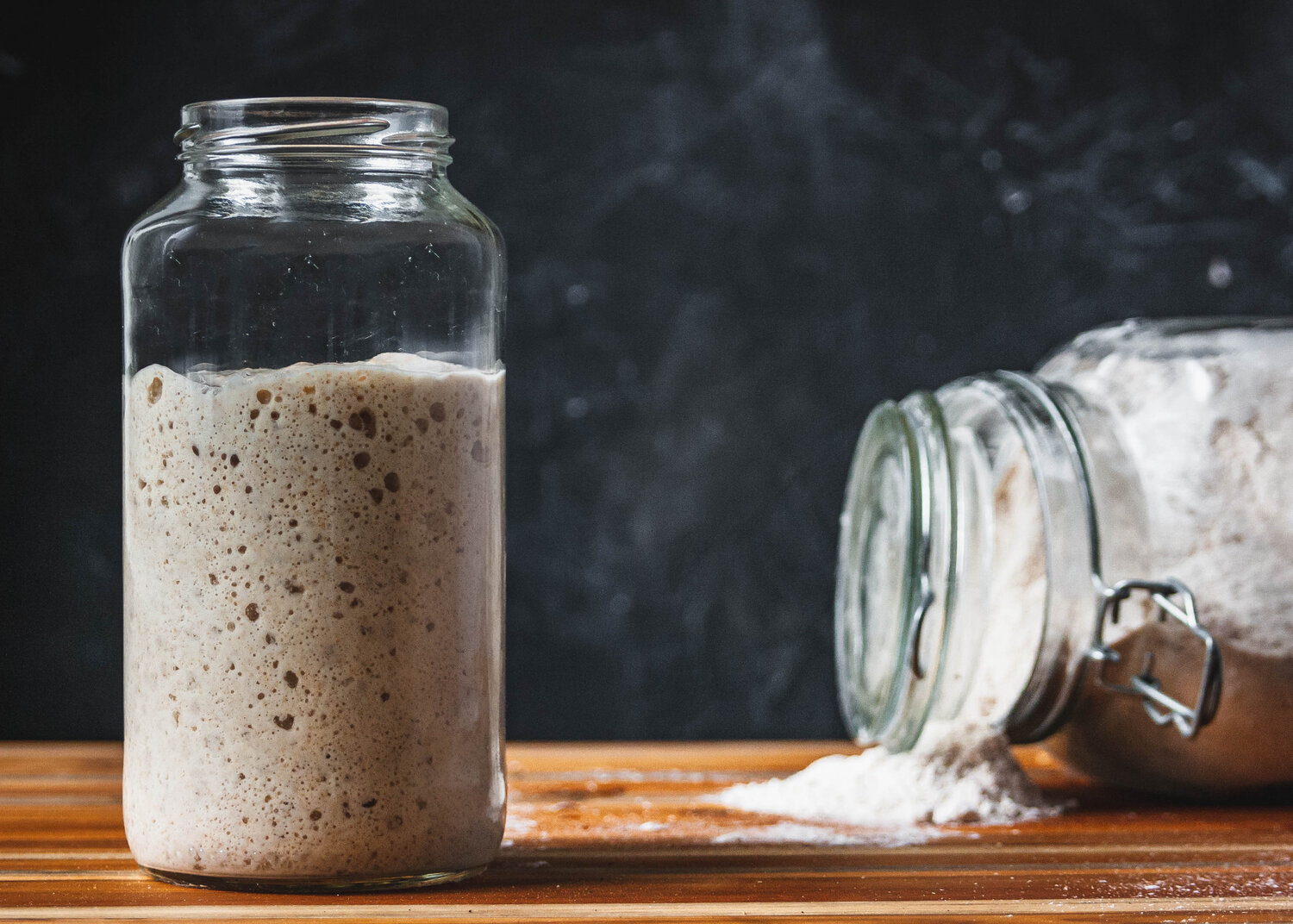Light Whole Wheat Sourdough
This whole wheat sourdough is one of my most frequently made recipes, and I hope it can become one of yours, too. With 20% whole wheat, the flavor of this bread is nutty, slightly sweet, and tangy, but the dough is not too difficult to handle. If you’ve never tried making your own sourdough bread before, start with my Beginner’s Sourdough Recipe and check out the Sourdough Baking Glossary for helpful tips for newbies.
Let’s introduce whole wheat into your sourdough baking.
If you’ve read my guide on how to make sourdough starter, you know that I am a big fan of whole wheat flour. At its simplest, flours labeled “whole wheat” are milled from wheat berries where the bran has not been sifted out, resulting in a darker color, deeper flavor, and increased nutritional profile from your standard all-purpose or bread flour. When feeding my sourdough starter, I like using whole wheat to give my natural yeast colony a healthy boost and keep it vigorously active for a great rise in my bread.
It should come as no surprise that adding whole wheat flour into your sourdough bread dough is a great way to bump up the flavor and nutrition. Whole wheat flour offers a variety of flavors, from sweet to nutty, to grassy, earthy, or slightly bitter, and when fermented over time in a dough, its use leads to a beautiful depth that creates even more caramelization on the crust and flavor in the crumb.
My favorite brand of whole wheat flour—which I recommend enthusiastically without endorsement—is King Arthur, which is widely available in the USA. Feel free to use any whole wheat flour you are able to access, but make sure to only buy as much as you think you will use in a few months. With more of the natural oils present, this flour is more prone to going rancid which would lead to unwanted flavors. You can also keep your flour in an airtight container in the freezer to extend its shelf life.
I scored this loaf with a wavy line pattern, which provided for a nice all-over rise. If you are new to sourdough scoring, you might want to keep it simple with an X pattern or a single slash down the center. Over time as you get a feel for the dough, you can get more decorative.
Tips for working with whole wheat flour
This bread recipe is not much different from my Beginner’s Sourdough Recipe, but there are a few tweaks made to adjust to the needs of whole wheat flour:
Starting with a small quantity of whole wheat flour—in this case, 1 part whole wheat to 4 parts bread flour—is a good way to learn how to introduce whole wheat into your baking and get a feel for how the dough behaves.
This recipe is 80% hydration, because whole wheat flour can absorb more water than white flour. While this may seem high, the dough is not very difficult to work with.
The bulk fermentation time is shorter than my beginner’s recipe, as whole wheat flour tends to speed up the fermentation process. With more natural oils and “food” for your sourdough starter present, it’s important to watch the bulk fermentation closely to make sure you don’t let it go too far. You’d be surprised how much dough can change in even 30-45 minutes of over-fermenting and you may be left with something too sticky and sour.
With those tips in mind, let’s take a look at the tools you’ll need to get started!
Tools I use to make sourdough bread:
Below are the tools you will need (listed in the order you will need them), along with the tools that are helpful to have. I’ve listed the tools I use and like first, with alternate suggestions where possible.
A clear-sided mixing bucket, or a large mixing bowl
A scale that measures in grams
A dough whisk, or a spatula to mix with
A bench scraper (I prefer metal)
A banneton (helpful) or a colander and rubber band
Rice flour for dusting your banneton or tea towel (helpful, but you can substitute all purpose or bread flour)
A plate
A lame, a new single-edged razor blade, or the sharpest knife you have
A dutch oven or pizza stone or baking tray
As an Amazon Associate, I earn on qualifying purchases. Your purchase through these links comes at no additional cost to you and helps me continue to deliver great recipes and maintain Bread & Basil.
The lame I link to is made by my friend Tyler of Wire Monkey Shop. I highly recommend this product and will receive a few dollars if you purchase the lame through my link.
How to make Light Whole Wheat Sourdough Bread
Here you see the dough after the stretch and folds are complete, when we let the dough rest for bulk fermentation. The dough is still a bit shaggy and sticky.
Here is the dough after bulk fermentation. It is visibly smoother in texture, more risen with bubbles throughout, and is no longer sticky.
The Process: an overview
The process for making this bread is very similar to the Beginner’s Sourdough Recipe on my site. The main stages you will go through are:
Mixing + “Fermentolyse”
The Final Proof
Scoring and Baking
Cooling and Cutting
If any of these terms are unfamiliar to you, I’ve conveniently linked to the section of my Sourdough Baking Glossary that explains in detail (often with video!) how to complete a step and what sensory cues to pay attention to. With the exception of bulk fermentation being a bit shorter, you can also check out this section of my beginner’s recipe to get a feel for how to feed your starter to prepare for this recipe, along with a sample baking schedule.
In the images above, you can see the dough after the final stretch and fold, and at the end of bulk fermentation a few hours later. Notice how the dough has visibly risen and is light, but there are not a ton of bubbles seen from the side of the container. You might be tempted to allow your dough to rise even further, getting more bubbly and voluminous, but I’ve found that pushing the bulk fermentation too far on a wheat dough can lead to a lot of trouble during shaping. Below is the same dough, viewed from above. The difference in height is less visible, but the texture is smoother and you can see bubbles populating the surface of the dough.
Temperature is a huge factor in bulk fermentation, and not one to be ignored. My room temperature hovers around 75°F, so the 4-6 hour total bulk fermentation time is based on this. If you have a colder house, your dough will ferment more slowly. In a warmer environment, it will go more quickly, so pay attention to the sensory cues described in the “Bulk Fermentation” explanation linked above and adjust accordingly.
The Dough Formula
Next, we’ll take a look at the dough formula. This is helpful information for scaling a recipe up or down, but if the percentages are confusing to you, just take a look at the ingredient weights.
Keep in mind, each percentage listed is in relation to the total flour weight, which in this case is 500 grams. For example, with a total flour weight of 500 grams, 400 grams of water represents 80% of the total weight of the flour.
Dough Formula
makes one loaf
| Ingredient | Weight | Baker's Percentage |
|---|---|---|
| Bread flour | 400 grams | 80% |
| Whole Wheat flour | 100 grams | 20% |
| Water (room temperature, about 75°F) | 400 grams | 80% |
| Sourdough starter (ripe) | 100 grams | 20% |
| Salt | 10 grams | 2% |
Even without doing the math, getting a feel for the baker’s percentages in a recipe can give you useful clues into how a recipe might behave. Some clues that the dough formula above gives us are:
With 80% bread flour and 20% wheat flour, this dough includes a modest amount of wheat, with bread flour making up the bulk for ease of handling. This is a really good starting point for incorporating wheat into your sourdough if you are new to it, because the more whole wheat you include, the trickier the dough can be to handle.
At 80% hydration, this bread will have a crumb structure that is moderately open. Whole wheat breads will always have a more dense crumb than white flour breads, but increasing the hydration helps keep it light.
With the starter being 20% of the weight of the flour, the dough will bulk ferment over the course of a few hours. Less starter = longer bulk fermentation times, more starter = shorter bulk fermentation times.
The salt content in bread is almost always around 2% of the total weight of the flour.
Now, without further ado, let’s get to the recipe!

Light Whole Wheat Sourdough Bread
Ingredients
Instructions
Notes:
You need ripe sourdough starter to make this recipe. If you would like to make your own, check out this guide!
Much of this recipe is similar to my Beginner's Sourdough Loaf, which has more helpful information if you are new to sourdough baking.
Wheat flour contains more natural enzymatic activity that makes rising times a bit faster than all-white flour breads. As such, pay attention to the sensory cues outlined in my Sourdough Baking Glossary to know how to properly time each step.











